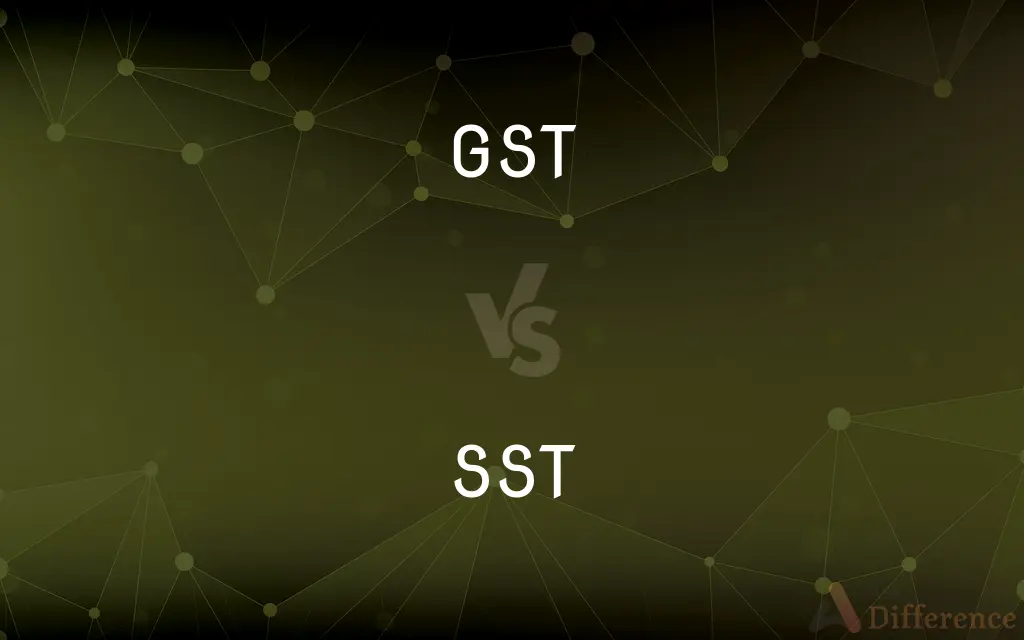GST vs. SST — What's the Difference?
By Tayyaba Rehman — Published on October 27, 2023
GST, or Goods and Services Tax, is a comprehensive, multi-stage, destination-based tax, while SST, or Sales and Service Tax, is a single stage tax applied at the point of manufacture or importation.

Difference Between GST and SST
Table of Contents
ADVERTISEMENT
Key Differences
GST, or Goods and Services Tax, is imposed at every stage of the production and distribution chain with the benefit of input tax credits. It typically consists of taxes on goods and services, enabling a transparent and uniform tax structure. On the other hand, SST or Sales and Service Tax, is levied at a single stage, either at the time of manufacturing or at the point of importation, leading to a system where tax cascading can occur.
In the realm of taxation, GST provides more comprehensive coverage, subsuming multiple indirect taxes under a unified umbrella, fostering uniformity and simplicity. In contrast, SST is generally considered more narrow in scope, applying predominantly to the manufacturing and importation sectors, and can lead to tax compounding due to its singular stage application.
GST is typically structured to be a destination-based tax, meaning it is applied where goods or services are consumed, contributing to equitable distribution of tax burden among consumers. SST, conversely, doesn’t adopt the destination principle, and is instead imposed at the manufacturing or importation level, possibly leading to uneven tax incidence on end consumers.
The implementation of GST aims at removing the cascading effect of taxes and provides credit for the input tax paid at each stage of production or service delivery. SST, by its very structure, does not mitigate tax cascading and does not offer input tax credit, potentially impacting the final pricing of goods and services.
Comparison Chart
Stages
Multi-stage
Single stage
ADVERTISEMENT
Scope
Comprehensive, includes various taxes
Narrow, primarily manufacturing and importation
Tax Cascading
Mitigates by allowing input tax credits
Can lead to tax compounding
Point of Levy
At every production and distribution stage
At the point of manufacture or importation
Tax Incidence
Equitable due to destination principle
Can be uneven due to single point levy
Compare with Definitions
GST
GST contributes to equitable distribution of tax burden among consumers.
With GST, consumers pay tax based on their consumption, ensuring fair tax incidence.
SST
SST primarily affects the manufacturing and importation sectors.
Manufacturers and importers need to be particularly compliant with SST regulations.
GST
GST is a multi-stage tax that provides credit for input tax paid at each stage of production.
Businesses can claim input tax credit under GST, reducing the cascading effect of taxes.
SST
SST does not mitigate tax cascading and does not offer input tax credits.
The lack of input tax credit in SST can impact the pricing of final goods and services.
GST
GST fosters uniformity and simplicity in the tax structure by including various taxes under a single umbrella.
The implementation of GST has made tax compliance easier due to its uniform structure.
SST
SST is generally considered narrower in scope compared to comprehensive tax systems like GST.
SST's limited scope means it doesn't subsume various indirect taxes like GST does.
GST
GST is a destination-based tax, applied where goods or services are consumed.
The revenue from GST goes to the government of the region where the goods or services are consumed.
SST
SST is a single-stage tax applied either at the manufacturing level or the point of importation.
The implementation of SST can lead to tax compounding as it is levied at a singular point.
GST
GST is a comprehensive indirect tax levied on the manufacture, sale, and consumption of goods and services.
The introduction of GST has streamlined the taxation system by subsuming multiple taxes into one.
SST
SST can lead to uneven tax incidence on end consumers.
Consumers might bear varied tax burdens depending on how SST is passed down through the production chain.
Common Curiosities
Does SST allow input tax credits?
No, SST does not provide for input tax credits, potentially leading to tax cascading.
Which tax is destination-based, GST or SST?
GST is a destination-based tax, applied where goods or services are consumed.
How does SST work?
SST is a single-stage tax imposed at the point of manufacture or importation.
Is GST more comprehensive than SST?
Yes, GST is more comprehensive as it subsumes various indirect taxes under one umbrella.
Can SST lead to uneven tax incidence?
Yes, SST can lead to uneven tax incidence due to its single point of levy.
Does GST mitigate the cascading effect of taxes?
Yes, GST mitigates tax cascading by allowing input tax credits at each production stage.
Is SST narrower in scope compared to GST?
Yes, SST is generally narrower in scope, primarily affecting manufacturing and importation sectors.
What is GST in simple terms?
GST is a comprehensive, multi-stage, destination-based tax on goods and services.
Can GST lead to simpler tax compliance?
Yes, GST can lead to simpler tax compliance due to its comprehensive and uniform structure.
Why is GST considered more equitable?
GST is considered more equitable due to its destination principle, ensuring fair tax incidence among consumers.
Can SST impact the pricing of goods and services?
Yes, SST can impact final pricing due to the lack of input tax credits and potential tax cascading.
Is SST applicable to various sectors?
SST is mainly applicable to the manufacturing and importation sectors.
How does GST foster uniformity in taxation?
GST fosters uniformity by subsuming multiple indirect taxes into a single, comprehensive tax structure.
How does GST impact consumers?
GST impacts consumers by distributing tax burden equitably based on consumption.
Does SST lead to tax compounding?
Yes, the single-stage nature of SST can lead to tax compounding.
Share Your Discovery

Previous Comparison
Glucon D vs. Glucon C
Next Comparison
Coercion vs. Undue InfluenceAuthor Spotlight
Written by
Tayyaba RehmanTayyaba Rehman is a distinguished writer, currently serving as a primary contributor to askdifference.com. As a researcher in semantics and etymology, Tayyaba's passion for the complexity of languages and their distinctions has found a perfect home on the platform. Tayyaba delves into the intricacies of language, distinguishing between commonly confused words and phrases, thereby providing clarity for readers worldwide.













































